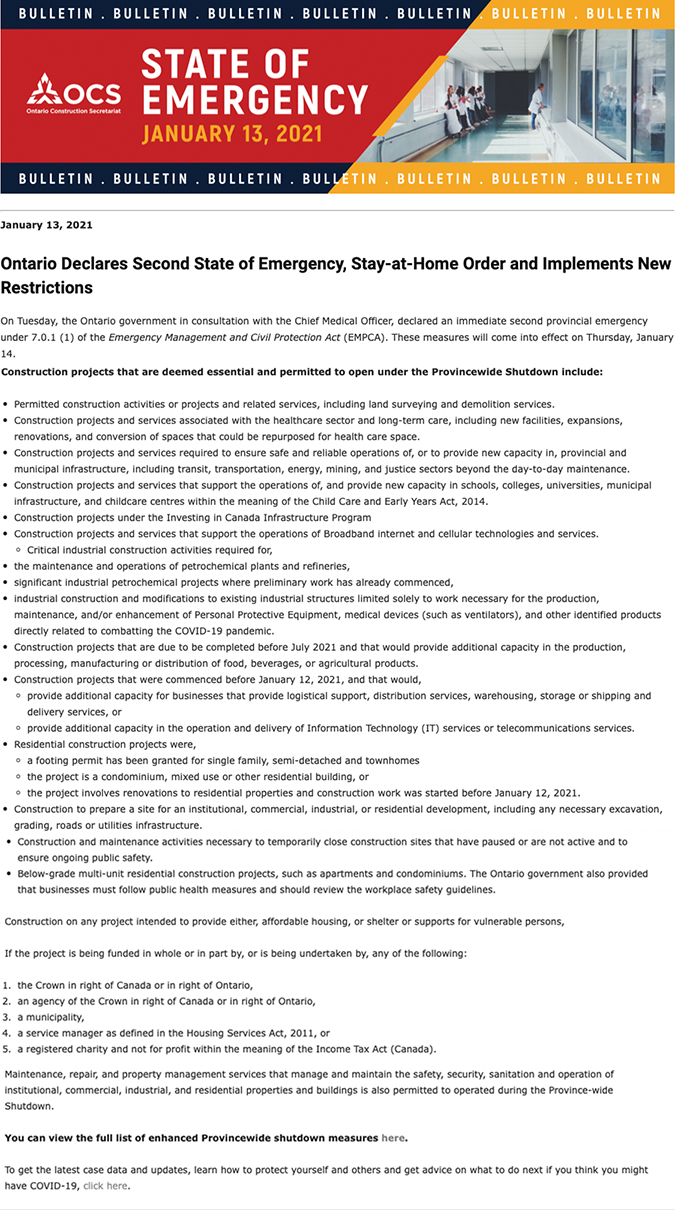
NEWS RELEASE January 21, 2021 — Ottawa — Impact Assessment Agency of Canada The Government of Canada oversees rigorous environmental assessments to ensure good projects that support economic growth and environmental protection get built. After a thorough review based on the best available science and evidence, and extensive public engagement, the Minister of Environment and Climate Change, the Honourable Jonathan Wilkinson, announced on January 21, 2021, the Government of Canada’s decision to approve the Milton Logistics Hub Project, subject to 325 conditions. The Milton Logistics Hub (the Project), proposed by the Canadian […]
NEWS RELEASE
January 21, 2021 — Ottawa — Impact Assessment Agency of Canada
The Government of Canada oversees rigorous environmental assessments to ensure good projects that support economic growth and environmental protection get built.
After a thorough review based on the best available science and evidence, and extensive public engagement, the Minister of Environment and Climate Change, the Honourable Jonathan Wilkinson, announced on January 21, 2021, the Government of Canada’s decision to approve the Milton Logistics Hub Project, subject to 325 conditions.
The Milton Logistics Hub (the Project), proposed by the Canadian National Railway Company (the Proponent), is expected to reduce overall regional emissions for certain pollutants, including greenhouse gas emissions, by transitioning from trucks to lower-emitting train shipment. The Project will also contribute to a resilient economic recovery from COVID-19 by strengthening Canada’s supply chains, attracting investment, and boosting Canada’s trade potential by addressing bottlenecks in important corridors.
In his Enviromental Assessment Decision Statement, the Minister established 325 legally-binding conditions on the Proponent to protect the environment and human health – many of which go beyond those initially proposed by the independent joint review panel and 40 of which address air quality specifically. Should the Proponent decide to go ahead with the Project, the conditions imposed would make it the most stringently regulated intermodal logistics hub in Canada, and among the most stringently regulated in North America. The conditions include measures to address effects on air quality, human health, groundwater and surface water, migratory birds, species at risk, fish and fish habitat, the use of lands and resources by Indigenous peoples, and physical and cultural heritage.
In response to concerns raised during the environmental review process regarding the potential for the Proponent to further expand the Project, as well as traffic and safety concerns, the Minister also established a legally-binding condition that will require the Proponent to limit truck traffic to 800 vehicles entering the site per day, averaged on a monthly basis. In addition the Proponent will also be required to establish a community liaison and communication process, and to document and respond to feedback from the community, as well as demonstrate how this feedback is addressed. This includes liaising with potentially affected parties to identify and address potential impacts on traffic and road safety.
The Impact Assessment Agency of Canada will enforce conditions before construction, during construction, and over the course of all project operations. Failure by the Canadian National Railway Company to meet these conditions is a violation of federal law. Any changes to the Project will need to be considered by the Minister through an amendment process to determine if they can proceed.
Going forward, the Proponent will also be required to obtain all necessary authorizations and/or permits. This includes an approval from the Canadian Transportation Agency under the s. 98 of the Canada Transportation Act.
In addition to the formal conditions, Environment and Climate Change Canada intends to work with the Government of Ontario to develop a regional air quality management strategy in the Greater Toronto Hamilton Area. Leveraging expertise from both governments and other potential partners, the strategy involves scientific work to inform the development of a plan to address air pollution from key sources in and around the region, many of which will remain irrespective of whether the proponent decides to proceed with the Project.
This collaboration is expected to support long-term health and environmental benefits to the seven million Canadians that live in the area, including in Milton, Ontario. Work on the development of the Strategy will take place over the next two years and will focus on actions that can be implemented quickly, as well as over the longer-term.
The World Health Organization consistently ranks Canada’s air among the cleanest in the world. However, there is more to be done, particularly in some regional airsheds, as some 25% of Canadians still live in areas where one or more national air quality standards are not being met. For that reason, the Government of Canada also intends to use the Strategy as a pilot approach to regional airshed management in Canada, under the Air Quality Management System.
QUOTE
“Canadians expect us to take meaningful action to protect the environment while also supporting economic growth, not just for today but for future generations. Today’s decision to approve the Milton Logistics Hub Project, which is subject to a wide range of conditions that the Proponent must comply with to protect human health and the environment, demonstrates that the federal regulatory process meets the economic and environmental objectives of Canadians at the same time.”
– The Honourable Jonathan Wilkinson, Minister of Environment and Climate Change




